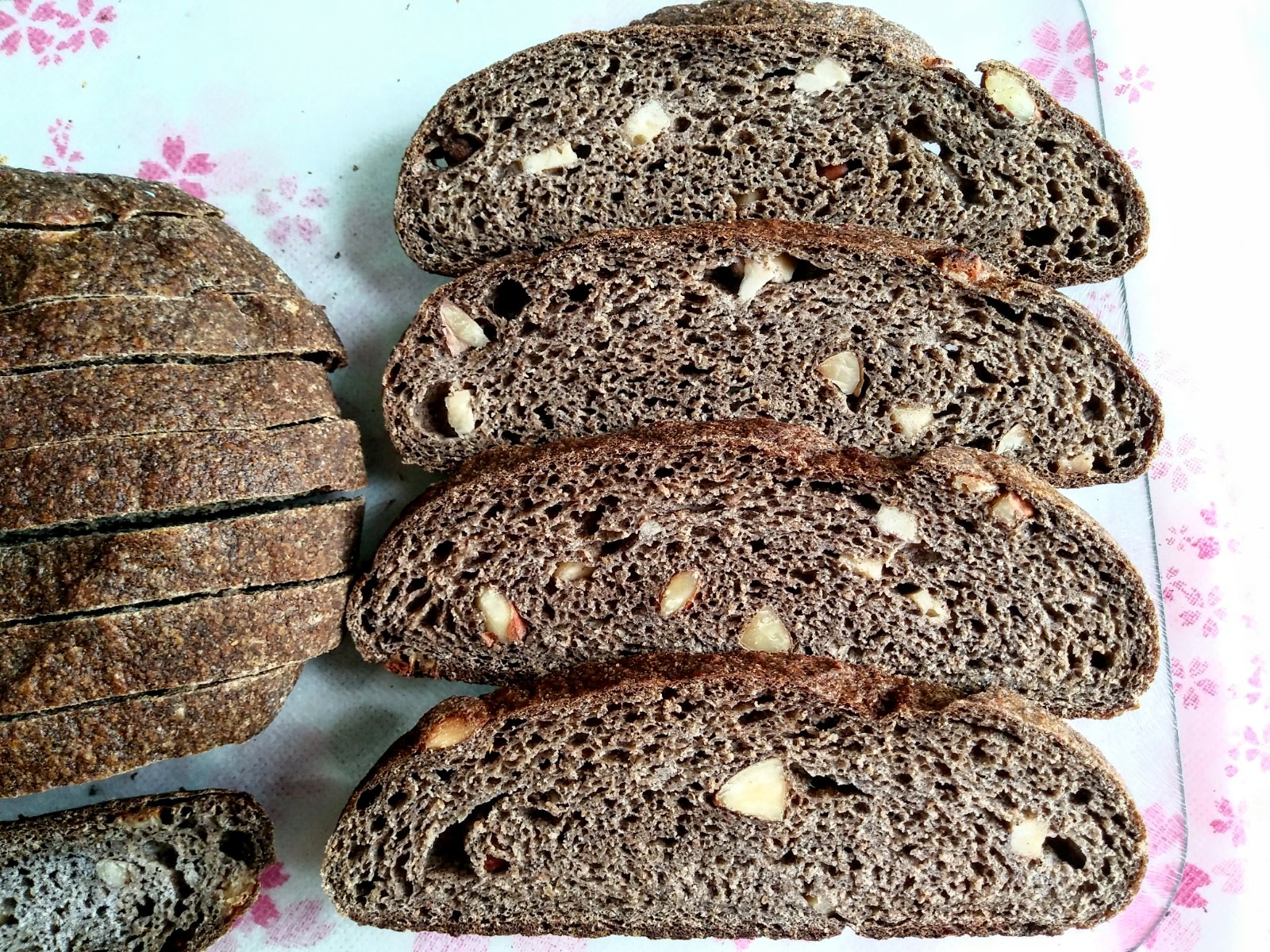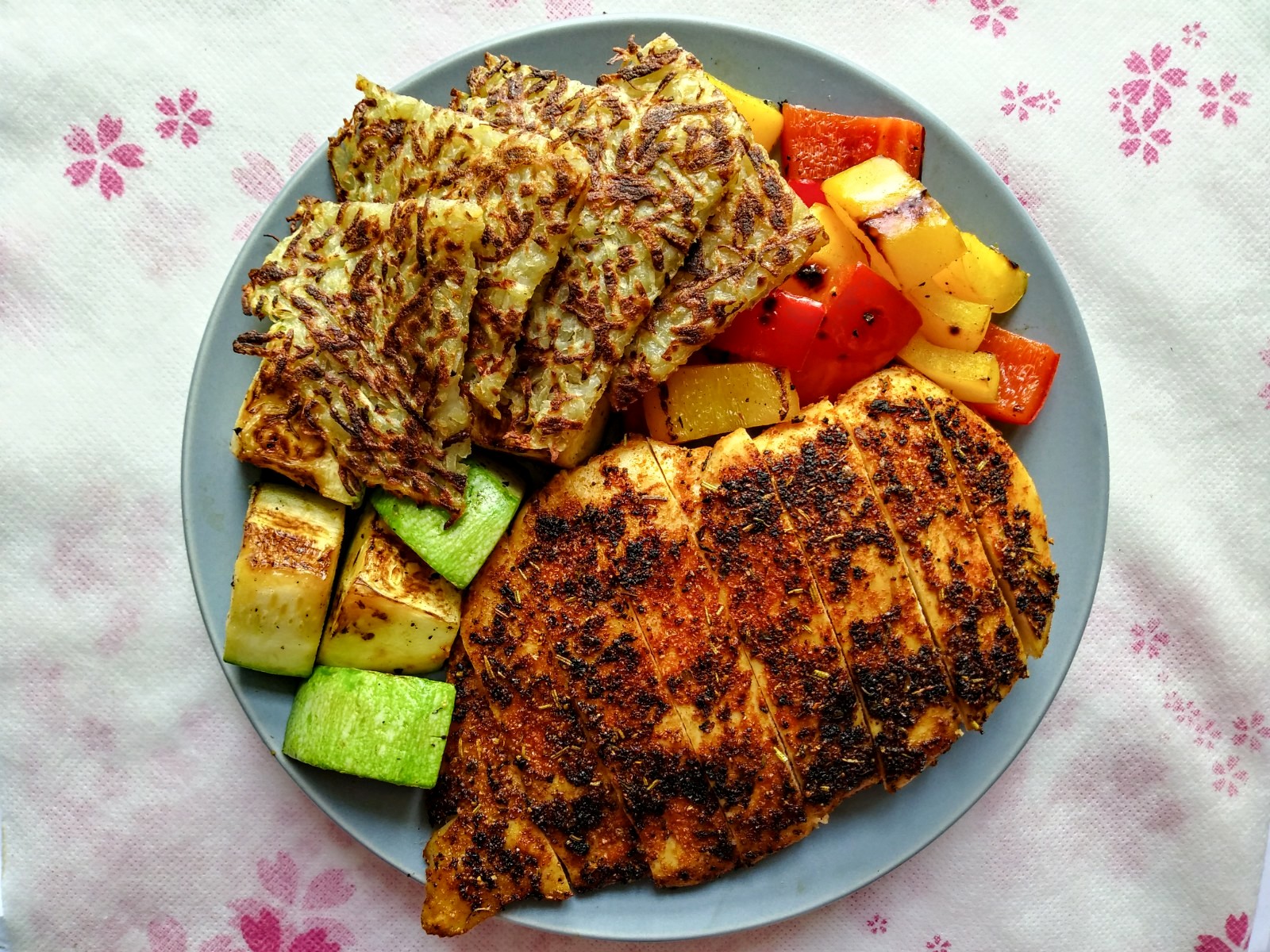
Since I started working with white dough, I’ve come to recognize the importance of gluten development in bread. Whole grain dough tends to be stiffer even when fully hydrated, which gives a delusion that dough mixing is neglectable. Wrong. I was so wrong! Two rounds of 3 minute mixing and 1 set of lamination contributed enormous elasticity and extensibility. The dough felt completely different and it does show in the crumb.

30% Sprouted Sorghum SD
| Dough flour | Final Dough | Levain | Total Dough | ||||
| g | % | g | % | g | % | g | % |
Flour (All Freshly Milled) | 300 | 100 | 273 | 100 | 27 | 100 | 303 | 100 |
Sprouted Sorghum Flour | 90 | 30 |
|
|
|
| 90 | 29.70 |
Whole Kamut Flour | 105 | 35 |
|
|
|
| 105 | 34.65 |
Whole Durum Flour | 105 | 35 |
|
|
|
| 105 | 34.65 |
White Whole Wheat Flour (Starter) |
|
|
|
|
|
| 1.5 | 0.50 |
Whole Rye Flour (Starter) |
|
|
|
|
|
| 1.5 | 0.50 |
|
|
|
|
|
|
|
|
|
Hydration |
|
|
|
| 30 | 100 | 283.78 | 93.66 |
Water |
|
| 172 | 63.00 | 27 | 100 | 202 | 66.67 |
Whey |
|
| 87 | 31.87 |
|
| 87 | 28.71 |
|
|
|
|
|
|
|
|
|
Salt | 5 | 1.67 | 5 | 1.83 |
|
| 5 | 1.65 |
Vital Wheat Gluten | 9 | 3 | 9 | 3.30 |
|
| 9 | 2.97 |
Starter (100% hydration) |
|
|
|
| 6 | 22.22 |
|
|
Levain |
|
| 60 | 21.98 |
|
|
|
|
|
|
|
|
|
|
|
|
|
Total |
|
| 606 | 221.98 | 60 | 222.22 | 606 | 200 |
Sift out the bran from dough flour, reserve 27 g for the leaven. Soak the rest, if any, in equal amount of whey taken from dough ingredients.
Combine all leaven ingredients and let sit until ready, about 5 hours (29.5°C). Roughly combine all dough ingredients. Ferment for a total of 4 hours (27.8°C) or until quite proofy. Construct 2 rounds of 3 minute Rubaud mixing at the 20 and 30 minute mark. Do a set of lamination at the 40 minute mark. 30 minutes before shaping, do a set of coil fold. Shape the dough then put in into a banneton directly. Freeze the dough for 30 minutes then retard in the fridge for 9 hours.
Preheat the oven at 250°C/482°F. Score and spritz the dough then bake straight from the fridge at 250°C/482°F with steam for 20 minutes then without steam for 25 minutes more or until the internal temperature reaches a minimum of 208°F. Let it cool for a minimum of 2 hours before slicing.

Sorghum tastes pretty mild. Not really much to be excited about. It makes the crumb a tad dense and dry as well… It’s too early to judge though. Let’s see how it performs in wheat/spelt dough later.

Last week’s bread. No freezing and thus slightly over-proofed.
| Dough flour | Final Dough | Levain | Total Dough | ||||
| g | % | g | % | g | % | g | % |
Flour (All Freshly Milled) | 300 | 100 | 272 | 100 | 28 | 100 | 304.5 | 100 |
Sprouted White Quinoa Flour | 60 | 20 |
|
|
|
| 60 | 19.70 |
Sprouted Black Quinoa Flour | 30 | 10 |
|
|
|
| 30 | 9.85 |
Whole Red Fife Wheat Flour | 150 | 50 |
|
|
|
| 150 | 49.26 |
Whole Spelt Flour | 60 | 20 |
|
|
|
| 60 | 19.70 |
White Whole Wheat Flour (Starter) |
|
|
|
|
|
| 2.25 | 0.74 |
Whole Rye Flour (Starter) |
|
|
|
|
|
| 2.25 | 0.74 |
|
|
|
|
|
|
|
|
|
Hydration |
|
|
|
| 32.5 | 100 | 274.1 | 90.02 |
Water |
|
| 157 | 57.72 | 28 | 100 | 189.5 | 62.23 |
Whey |
|
| 90 | 33.09 |
|
| 90 | 29.56 |
|
|
|
|
|
|
|
|
|
Salt | 5 | 1.67 | 5 | 1.84 |
|
| 5 | 1.64 |
Vital Wheat Gluten | 9 | 3 | 9 | 3.31 |
|
| 9 | 2.96 |
Starter (100% hydration) |
|
|
|
| 9 | 32.14 |
|
|
Levain |
|
| 65 | 23.90 |
|
|
|
|
|
|
|
|
|
|
|
|
|
Add-ins | 54 | 18 | 54 | 19.85 |
|
| 54 | 17.73 |
Toasted Almonds | 30 | 10 | 30 | 11.03 |
|
| 30 | 9.85 |
Halloumi, Cubed | 24 | 8 | 24 | 8.82 |
|
| 24 | 7.88 |
|
|
|
|
|
|
|
|
|
Total |
|
| 652 | 239.71 | 65.00 | 232.14 | 652 | 214.12 |

 Collapsed in the oven
Collapsed in the oven
Because of the increased extensibility, there’s a higher tendency for the dough to spread out in the oven. Letting it become quite proofy before shaping improves its strength. Yet, this leads to another problem of over-proofing… Freezing it briefly before the retard helps solve the issue by lowering the dough temperature.
_____

Korean japchae topped with a fried egg

Garlicky linguine with salmon & brussel sprouts

Scrambled eggs with shrimps & Stir fried leeks and cabbages with steamed rice

Spicy grilled chicken breast with pan grilled zucchini & bell peppers, and potato rosti

Dry brined


Shrimp & spicy chorizo paella, rutabaga & leek casserole, pressure cooked pork chop braised in a tomato-carrot-onion-caperberry sauce, and pan grilled asparagus & brussel sprouts with boiled eggs & diced red peppers

Tomato herb (rosemary & thyme) soft bread
Huge thanks to my friend who kept bugging me to work the dough more :)
- Elsie_iu's Blog
- Log in or register to post comments
I've never done much with sorghum except putting the syrup in stuff. I don't usually dry rub chicken breast until it has been wet brined first and then I leave out the salt on the rub. Salt in dry rub just sucks the moisture out of the breast which is already pretty dry after being grilled but yours looks like turned out really juicy and perfectly cooked.
Love that shrimp and spicy chorizo paella the best - another rice dish I can't really eat but I can pick out the shrimp and chorizo:-) The pork chops look nice an juicy too. The instant pot is a blessing fr sure! Just love the thing!
Everything looks grand! Happy baking Elsie!
has a firm yet moist texture than I enjoy. Yes water is drawn out but it wouldn't result in a drier breast. The opposite is true in fact. I believe it works like curing meat. The final product is a springy, plump piece of ham. Wet brined breast is juicy while still having the somewhat stringy texture of traditionally cooked chicken (duh). In contrast, dry brined one tastes more like well-cooked pork chop, which is a real treat to me. Oh well maybe I just prefer pork to chicken :) I'll definitely try a marinade next time for variations. You know I can't stand feeling bored! The spices weren't rubbed on with the salt. They were pressed onto the breast right before cooking as they would have turned into a wet mess otherwise...
The chorizo is the best part of the paella. Rather than letting them simmer with the rice, I like to add it towards the end. Usually I would first render all of the fat out over low heat. Then the aromatics get sauteed in that priceless dripping. The crispy chorizo is only added back with the seafood when the rice is 90% cooked. I also like to reserve some of it to be sprinkled over the paella. This way you have both crunchy chorizo and flavor-infused rice! Love my pressure cooker for sure. It's such a time-saver. I wouldn't be able to cook a lot of the dishes I made if it wasn't invented.
Glad you like the food and bread dabrownman! This way of working the dough really opens the crumb up. I'm sure its potential isn't fully unleashed yet. We shall see!
You had me at the chorizo paella...I wasn't even hungry and it's late!
Seriously, what more can you ask for? One-pan meals like paella are such crowd pleasers! They're the kind of dishes my parents like the most too. The carbs underneath turn ultra flavorful after soaking up all the wonderful juices. I love all kinds of smoked and spiced cured meat that there're always some in my freezer... They for sure get a bad rap for being carcinogenic but a little goes a long way.
Glad you like the paella! Maybe make some for dinner yourself considering how effortless it is? :)